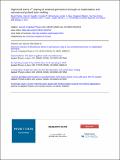| dc.contributor.author | Pastor, David | |
| dc.contributor.author | Gandhi, Hemi H | |
| dc.contributor.author | Monmeyran, Corentin P | |
| dc.contributor.author | Akey, Austin J | |
| dc.contributor.author | Milazzo, Ruggero | |
| dc.contributor.author | Cai, Yan | |
| dc.contributor.author | Napolitani, Enrico | |
| dc.contributor.author | Gwilliam, Russell M | |
| dc.contributor.author | Crowe, Iain F | |
| dc.contributor.author | Michel, Jurgen | |
| dc.contributor.author | Kimerling, LC | |
| dc.contributor.author | Agarwal, Anuradha | |
| dc.contributor.author | Mazur, Eric | |
| dc.contributor.author | Aziz, Michael J | |
| dc.date.accessioned | 2021-10-27T20:10:22Z | |
| dc.date.available | 2021-10-27T20:10:22Z | |
| dc.date.issued | 2018 | |
| dc.identifier.uri | https://hdl.handle.net/1721.1/135024 | |
| dc.description.abstract | © 2018 Author(s). Obtaining high level active n+ carrier concentrations in germanium (Ge) has been a significant challenge for further development of Ge devices. By ion implanting phosphorus (P) and fluorine (F) into Ge and restoring crystallinity using Nd:YAG nanosecond pulsed laser melting (PLM), we demonstrate 1020 cm-3 n+ carrier concentration in tensile-strained epitaxial germanium-on-silicon. Scanning electron microscopy shows that after laser treatment, samples implanted with P have an ablated surface, whereas P + F co-implanted samples have good crystallinity and a smooth surface topography. We characterize P and F concentration depth profiles using secondary ion mass spectrometry and spreading resistance profiling. The peak carrier concentration, 1020 cm-3 at 80 nm below the surface, coincides with the peak F concentration, illustrating the key role of F in increasing donor activation. Cross-sectional transmission electron microscopy of the co-implanted sample shows that the Ge epilayer region damaged during implantation is a single crystal after PLM. High-resolution X-ray diffraction and Raman spectroscopy measurements both indicate that the as-grown epitaxial layer strain is preserved after PLM. These results demonstrate that co-implantation and PLM can achieve the combination of n+ carrier concentration and strain in Ge epilayers necessary for next-generation, high-performance Ge-on-Si devices. | |
| dc.language.iso | en | |
| dc.publisher | AIP Publishing | |
| dc.relation.isversionof | 10.1063/1.5012512 | |
| dc.rights | Article is made available in accordance with the publisher's policy and may be subject to US copyright law. Please refer to the publisher's site for terms of use. | |
| dc.source | other univ website | |
| dc.title | High level active n + doping of strained germanium through co-implantation and nanosecond pulsed laser melting | |
| dc.type | Article | |
| dc.contributor.department | Massachusetts Institute of Technology. Department of Materials Science and Engineering | |
| dc.contributor.department | MIT Materials Research Laboratory | |
| dc.relation.journal | Journal of Applied Physics | |
| dc.eprint.version | Final published version | |
| dc.type.uri | http://purl.org/eprint/type/JournalArticle | |
| eprint.status | http://purl.org/eprint/status/PeerReviewed | |
| dc.date.updated | 2019-09-20T18:17:29Z | |
| dspace.orderedauthors | Pastor, D; Gandhi, HH; Monmeyran, CP; Akey, AJ; Milazzo, R; Cai, Y; Napolitani, E; Gwilliam, RM; Crowe, IF; Michel, J; Kimerling, LC; Agarwal, A; Mazur, E; Aziz, MJ | |
| dspace.date.submission | 2019-09-20T18:17:30Z | |
| mit.journal.volume | 123 | |
| mit.journal.issue | 16 | |
| mit.metadata.status | Authority Work and Publication Information Needed | |
